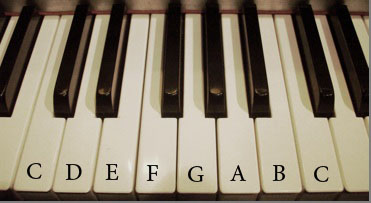Major Scales
The major scale is a great way to delve into music theory; many people know what it is but don't understand the theory behind it. However, before we get into it, let's go over the concept of whole steps and half steps:
A half step is the term for the distance of any two notes that are next to one another. For example: F to F#, or A to Ab, or C to B.
A whole step is the term for the distance of any two notes that have exactly one note between them. For example: F to G, or Bb to Ab, or B to C#.
Now a major scale is constructed of the following pattern of whole steps (W) and half steps (H):
W W H W W W H
This is easy to visualize with a major scale on the piano in the key of C:

The two half steps in a C major scale occur between E and F and B and C. The black notes are the notes that are in between each whole step. Therefore, on a piano, a C major scale is all white notes.
*Note that regardless of the instrument, in music there is never a note in between E and F or B and C.
Yes there are 12 different notes/keys and each one has it's own major scale. It's very important to be familiar with all 12 major keys. It's a tough project to learn them all and it does help to have the guidance of a teacher or a knowledgeable musician.
To really understand chord theory and harmony, it helps to know the number (also called the scale degree) of each note in the major scale. In the C major scale it is this:
C is the 1st note
D is the 2nd note
E is the 3rd note
F is the 4th note
G is the 5th note
A is the 6th note
B is the 7th note
C is the 8th note
As you can see, C major is pretty easy. Let's look at F# major:
F# is the 1st note
G# is the 2nd note
A# is the 3rd note
B is the 4th note
C# is the 5th note
D# is the 6th note
E# (also known as F) is the 7th note
F# is the 8th note
That one is a little trickier. Well go ahead and learn those major scales!
Congratulations, you're now ready for Music Intervals Or if you are looking for more scales, check out the minor scale